CBCT Imaging in Dentistry: History, Techniques, and Radiation Protection
Added on 2023-06-05
25 Pages11050 Words317 Views
3.0 Background:
3.1 History of X-rays
Radiography refers to the imaging technique that depends on the use of x-rays for
viewing the internal forms of a biological object (USFDA, 2018). The process of
radiography encompasses creation of a beam of electromagnetic radiation, or x-rays
that are produced from a generator and projected towards the object, currently being
viewed (Dance, et. al., 2014). The discovery of x-rays is credited to Wilhelm Röntgen,
the German physicist, who was the first person to systematically conduct a study on
its functions. X-rays were found to get emanated from discharge tubes, commonly
known as Crookes tubes, which produced free electrons by residual air ionization.
Radiological cars were developed in 1914 for supporting the soldiers injured during
World War 1.
Radiographic techniques is are used in dentistry by the professionals to help
evaluate oral health. Commonly known as dental x-rays are performed to by
detecting detect the development or progress of a dental disease or treatment.
Assessment of the dental and periodontal tissues through radiography is a vital
component of the detailed oral examination and serves as a diagnostic tool (Acar &
Kamburoğlu, 2014). Exposure of radiation linked with dentistry procedures signifies a
small part to the total exposure from each of the sources (Okano & Sur, 2010). The
digital period of dental radiography started in 1988 with RVG, radio/visio/graphy. The
film-like sensor was first presented in 1994. Radio visiography (RVG) is a direct
digital method of radiography. It is utilized for recognizing carious lesions, evaluating
root lengths, and in diagnosing periapical pathology and root fractures (Deepak, et
al., 2012). Apart from the reduction in radiation exposure, digital radiography also
facilitated effective communication of electronic data, offers portability, and
eradicates the environmental load of silver and other chemicals utilised to create X-
rays (Stelt, 2005).
3.2 Imaging in endodontics
Dental x-rays play an important role in visualising dental anatomy, surrounding
structures and any pathology in endodontic diagnosis and treatment planning (Patel
et al., 2015). Historically, intra-oral peri-apical radiographs have been the most
accurate diagnostic aids that are used by endodontists for diagnosing diseases that
affects the mandible and maxilla (Patel at al. 2009).
Several imaging techniques are available to endodontics as diagnostic aid.
Ultrasound (US) and Magnetic resonance imaging (MRI) are utilized to assess
normal and diseased states of the bones and soft tissues of the oral and maxillofacial
area (Senthil Kumar & Nazargi, 2010). Radio visiography (RVG) is a direct digital
3.1 History of X-rays
Radiography refers to the imaging technique that depends on the use of x-rays for
viewing the internal forms of a biological object (USFDA, 2018). The process of
radiography encompasses creation of a beam of electromagnetic radiation, or x-rays
that are produced from a generator and projected towards the object, currently being
viewed (Dance, et. al., 2014). The discovery of x-rays is credited to Wilhelm Röntgen,
the German physicist, who was the first person to systematically conduct a study on
its functions. X-rays were found to get emanated from discharge tubes, commonly
known as Crookes tubes, which produced free electrons by residual air ionization.
Radiological cars were developed in 1914 for supporting the soldiers injured during
World War 1.
Radiographic techniques is are used in dentistry by the professionals to help
evaluate oral health. Commonly known as dental x-rays are performed to by
detecting detect the development or progress of a dental disease or treatment.
Assessment of the dental and periodontal tissues through radiography is a vital
component of the detailed oral examination and serves as a diagnostic tool (Acar &
Kamburoğlu, 2014). Exposure of radiation linked with dentistry procedures signifies a
small part to the total exposure from each of the sources (Okano & Sur, 2010). The
digital period of dental radiography started in 1988 with RVG, radio/visio/graphy. The
film-like sensor was first presented in 1994. Radio visiography (RVG) is a direct
digital method of radiography. It is utilized for recognizing carious lesions, evaluating
root lengths, and in diagnosing periapical pathology and root fractures (Deepak, et
al., 2012). Apart from the reduction in radiation exposure, digital radiography also
facilitated effective communication of electronic data, offers portability, and
eradicates the environmental load of silver and other chemicals utilised to create X-
rays (Stelt, 2005).
3.2 Imaging in endodontics
Dental x-rays play an important role in visualising dental anatomy, surrounding
structures and any pathology in endodontic diagnosis and treatment planning (Patel
et al., 2015). Historically, intra-oral peri-apical radiographs have been the most
accurate diagnostic aids that are used by endodontists for diagnosing diseases that
affects the mandible and maxilla (Patel at al. 2009).
Several imaging techniques are available to endodontics as diagnostic aid.
Ultrasound (US) and Magnetic resonance imaging (MRI) are utilized to assess
normal and diseased states of the bones and soft tissues of the oral and maxillofacial
area (Senthil Kumar & Nazargi, 2010). Radio visiography (RVG) is a direct digital
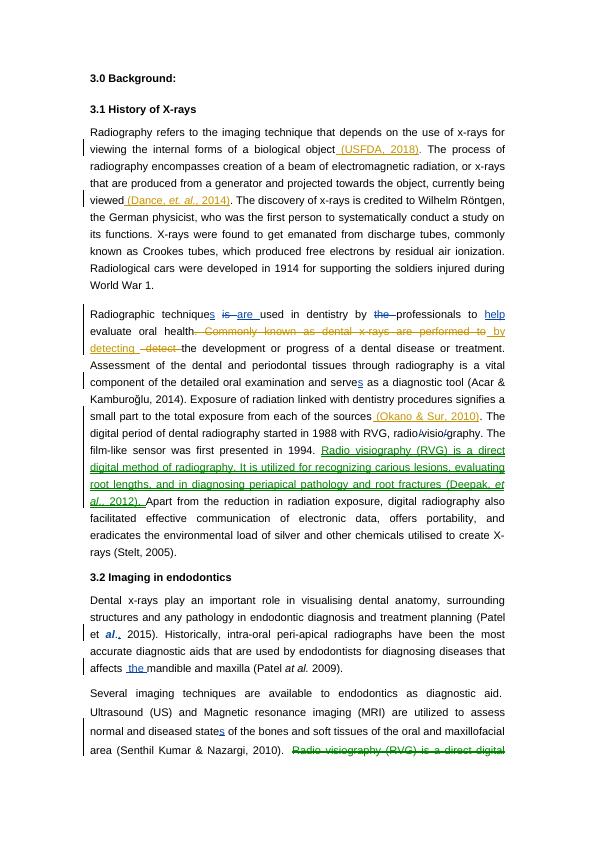
method of radiography. It is utilized for recognizing carious lesions, evaluating root
lengths, and in diagnosing periapical pathology and root fractures (Deepak, et al.,
2012).
Computed tomography (CT) is another significant imaging technique used in head
and neck anomalies (Dammann, et. al., 2014) Bootz, Cohnen, Haßfeld, & Tatagiba,
2014) . CT is used to image the anatomical structures of the maxillo-facial structures,
including facial skeleton (Dammann, et. al., 2014) (Dammann, Bootz, Cohnen,
Haßfeld, & Tatagiba, 2014). A CT scan uses computer-processed combinations of
several X-ray measurements taken from different angles to generate cross-sectional
(tomographic) images of particular regions of a scanned item, enabling to view inside the
item without cutting. CT generates data that can be manipulated in order to show
different bodily structures on the basis of their capability to absorb the X-ray beam. In
previous times, the images that were produced were in the axial or transverse plane,
perpendicular to the long axis of the body, but in current times the volume of data is
formatted in several planes or even as volumetric (3D) representations of structures.
Apart from the medicine, CT is also used in other fields, such as nondestructive materials
testing, archaeological uses, etc. Historically, in endodontics CT imaging was rarely
used, although it has been documented in literature (Scarfe, et. al., 2009).
Cone-beam computed tomography (CBCT) is an instrumental development for
assessment of endodontic cases. It is also a digital imaging technique, which is
particularly developed to generate exact 3-D information of the maxillofacial skeleton,
3-D images of the teeth and the adjacent tissues. CBCT is a method which
includes X-ray computed tomography where the X-rays are divergent, forming a cone
(Scarfe, et. al., 2006). During dental or orthodontic imaging, the CBCT scanner
rotates around the person’s head, obtaining up to around 600 separate images. For
interventional radiology, the patient is positioned offset to the table so that the region
of interest is centered in the field of view for the cone beam. A single 200 degree
rotation over the region of interest acquires a volumetric data set. The scanning
software gathers the information and reconstructs it, generating what is referred to
as digital volume composed of three-dimensional voxels of anatomical data that can
then be manipulated and visualized with specified software (Hatcher, 2010). CBCT
has several similarities with conventional (fan beam) CT but there are various
differences, specifically for reconstruction. CBCT is viewed as the gold standard for
imaging the oral and maxillofacial area. CBCT has become increasingly important in
treatment planning and diagnosis in implant dentistry, ENT, orthopedics,
and interventional radiology (IR), among other things. Due to the increased access to
lengths, and in diagnosing periapical pathology and root fractures (Deepak, et al.,
2012).
Computed tomography (CT) is another significant imaging technique used in head
and neck anomalies (Dammann, et. al., 2014) Bootz, Cohnen, Haßfeld, & Tatagiba,
2014) . CT is used to image the anatomical structures of the maxillo-facial structures,
including facial skeleton (Dammann, et. al., 2014) (Dammann, Bootz, Cohnen,
Haßfeld, & Tatagiba, 2014). A CT scan uses computer-processed combinations of
several X-ray measurements taken from different angles to generate cross-sectional
(tomographic) images of particular regions of a scanned item, enabling to view inside the
item without cutting. CT generates data that can be manipulated in order to show
different bodily structures on the basis of their capability to absorb the X-ray beam. In
previous times, the images that were produced were in the axial or transverse plane,
perpendicular to the long axis of the body, but in current times the volume of data is
formatted in several planes or even as volumetric (3D) representations of structures.
Apart from the medicine, CT is also used in other fields, such as nondestructive materials
testing, archaeological uses, etc. Historically, in endodontics CT imaging was rarely
used, although it has been documented in literature (Scarfe, et. al., 2009).
Cone-beam computed tomography (CBCT) is an instrumental development for
assessment of endodontic cases. It is also a digital imaging technique, which is
particularly developed to generate exact 3-D information of the maxillofacial skeleton,
3-D images of the teeth and the adjacent tissues. CBCT is a method which
includes X-ray computed tomography where the X-rays are divergent, forming a cone
(Scarfe, et. al., 2006). During dental or orthodontic imaging, the CBCT scanner
rotates around the person’s head, obtaining up to around 600 separate images. For
interventional radiology, the patient is positioned offset to the table so that the region
of interest is centered in the field of view for the cone beam. A single 200 degree
rotation over the region of interest acquires a volumetric data set. The scanning
software gathers the information and reconstructs it, generating what is referred to
as digital volume composed of three-dimensional voxels of anatomical data that can
then be manipulated and visualized with specified software (Hatcher, 2010). CBCT
has several similarities with conventional (fan beam) CT but there are various
differences, specifically for reconstruction. CBCT is viewed as the gold standard for
imaging the oral and maxillofacial area. CBCT has become increasingly important in
treatment planning and diagnosis in implant dentistry, ENT, orthopedics,
and interventional radiology (IR), among other things. Due to the increased access to
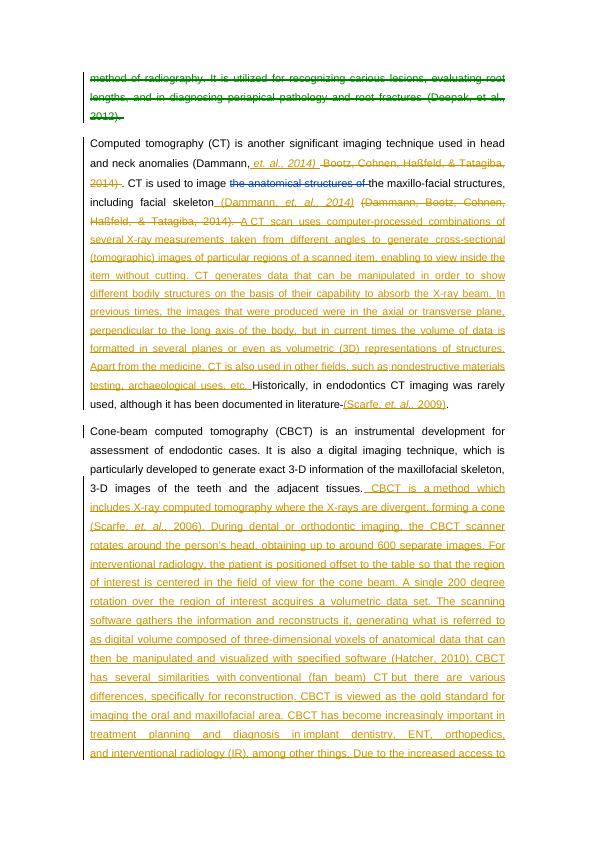
such technology, CBCT scanners have become a common tool in dentistry, like in
the fields of oral surgery, endodontics and orthodontics. Integrated CBCT is also a
significant method for positioning the patient and verification in image-guided
radiation therapy (IGRT).
3.3 History of CT and CBCT
A new invention, commonly known as computed tomography was developed in the
year 1972 that brought about major transformation in diagnostic medicine. No
significant changes were observed in geometry for imaging dentition since 1896. The
very first publication of CT technology in management of endodontic problems was
carried out by Tachibana & Matsumoto (1990). Although CT technology had been
around for quite some time, the recognition of CT in endodontic use has been
delayed due to high radiation dose for a small area, relatively poor resolution of
images generated and high cost of purchasing the CT unit. The technique of CT scan
progressed to CBCT; a method found by the British engineer Godfrey Hounsfield in
1967 (Bhattacharyya, 2016). CBCT technology has overtaken CT scans in
management of Oral and maxillofacial problems.
CBCT or cone beam computed tomography; the medical imaging technique based
on x-ray computed tomography has gained attention in the recent years. This
technique was introduced in 1996 in Europe by QR s.r.l. and in 2001 the first CBCT
machine New Tom 9000 was installed in US market. CBCT has numerous potential
advantages for dental imaging, compared with conventional CT scans. Some of the
benefits can beare; the ability to reducetion in the field of view, thereby reducing the
size of irradiation (Scarfe et.al .,2016), image accuracy as the CBCT voxels (a value
on a regular grid in three-dimensional space) can be extremely low, producing high
quality resolution images, reduced scan time compared to conventional CT (White
and & Pharoah, 2018), effective dose reduction (Ludlow et. al. ,2007), reducing
image artefacts by use of suppression algorithms in the software (Cohen et.al. 2002).
CBCT started to appear in research journals of dentistry after 2 years of introduction
of 3D dental software in dentistry by Columbia Scientific Inc. (Orentlicher, et.al.,
2012) Goldsmith, & Abboud, 2012). When dental professionals started using CBCT
in dentistry, they found enhanced clarity of structures, anatomy and recognition of
oral pathology (Scarfe, et. al., 2009). There was a clear distinction of individual
structures and its relationship with adjacent anatomical structures (Shukla, et.al.,
2017)Chug, & Afrashtehfar, 2017). CBCT has been proven as a
groundbreakingground-breaking invention as it simplified the process of decision-
the fields of oral surgery, endodontics and orthodontics. Integrated CBCT is also a
significant method for positioning the patient and verification in image-guided
radiation therapy (IGRT).
3.3 History of CT and CBCT
A new invention, commonly known as computed tomography was developed in the
year 1972 that brought about major transformation in diagnostic medicine. No
significant changes were observed in geometry for imaging dentition since 1896. The
very first publication of CT technology in management of endodontic problems was
carried out by Tachibana & Matsumoto (1990). Although CT technology had been
around for quite some time, the recognition of CT in endodontic use has been
delayed due to high radiation dose for a small area, relatively poor resolution of
images generated and high cost of purchasing the CT unit. The technique of CT scan
progressed to CBCT; a method found by the British engineer Godfrey Hounsfield in
1967 (Bhattacharyya, 2016). CBCT technology has overtaken CT scans in
management of Oral and maxillofacial problems.
CBCT or cone beam computed tomography; the medical imaging technique based
on x-ray computed tomography has gained attention in the recent years. This
technique was introduced in 1996 in Europe by QR s.r.l. and in 2001 the first CBCT
machine New Tom 9000 was installed in US market. CBCT has numerous potential
advantages for dental imaging, compared with conventional CT scans. Some of the
benefits can beare; the ability to reducetion in the field of view, thereby reducing the
size of irradiation (Scarfe et.al .,2016), image accuracy as the CBCT voxels (a value
on a regular grid in three-dimensional space) can be extremely low, producing high
quality resolution images, reduced scan time compared to conventional CT (White
and & Pharoah, 2018), effective dose reduction (Ludlow et. al. ,2007), reducing
image artefacts by use of suppression algorithms in the software (Cohen et.al. 2002).
CBCT started to appear in research journals of dentistry after 2 years of introduction
of 3D dental software in dentistry by Columbia Scientific Inc. (Orentlicher, et.al.,
2012) Goldsmith, & Abboud, 2012). When dental professionals started using CBCT
in dentistry, they found enhanced clarity of structures, anatomy and recognition of
oral pathology (Scarfe, et. al., 2009). There was a clear distinction of individual
structures and its relationship with adjacent anatomical structures (Shukla, et.al.,
2017)Chug, & Afrashtehfar, 2017). CBCT has been proven as a
groundbreakingground-breaking invention as it simplified the process of decision-
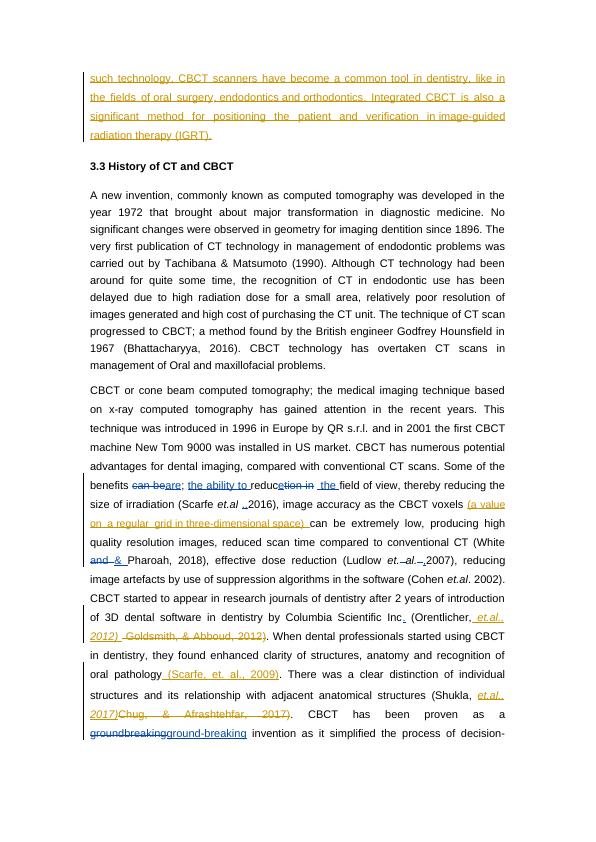
making and eased the detection of defects in bony structures from several angles
(Shukla, et.al., 2017) Chug, & Afrashtehfar, 2017).
3.4 Effects of ionizing radiation
The major deleterious effects of ionising radiations are primarily categorised into two
different types namely, stochastic and deterministic effects. The deterministic effects
occur when the exposure threshold is exceeded which means deterministic effects,
such as skin injuries and cataract formation, takes place when dose exceeds a
particular threshold (Roobottom, et. al., 2010). Deterministic effect severity is directly
proportional to exposure dose. Some of the most common effects are cataract,
sterility, skin erythrema, and radiation sickness.
However, the stochastic effects follow some linear-no-threshold hypothesis that
occurs due to ionising effects of symmetrical translocation. Stochastic effects have
no radiation dose threshold and therefore are linked with the low radiation doses
given during CT. These effects have a long latent period, occur randomly and are
dependent on the level and type of radiation given, the tissue undergoing radiation
and the age of the person. These lead to cancer, and several hereditary defects such
as, Down syndrome. The risk of cancer development is found to follow some linear,
that is straight pattern with an increase in radiation dose (Palma et al. 2013).
The effective doses of ionising radiation are used for measuring them in terms of
their harm inflicting potential and are measured as Sievert (Sv) units. This unit also
takes into consideration the kind of radiation and organ or tissue sensitivity. The
stochastic effects of ionising radiation appear several decades later and their
likelihood is proportional to the dose of radiation. One particular study suggestedit
Study conducted by Warhekar et.al., has been reported that 35.6% general private
practitioners refer CBCT. Oral radiologists (14.2%) and surgeons (21.9%) are found
to be the frequent groups who referred patients for CBCT to the patients, followed by
prosthodontists and orthodontists (Warhekar et al. 2015). The technique is also
referred for the use of conservative dentistry, oral diagnosis, and general dentistry.
Another study Further evidence is provided by another study evidence for the fact
that periodontistscs (21%), prosthodontistscs (14%), and dental professionals with
advance education in dentistry (13%) were some of the most requested resident
providers, with regards to use of CBCT (Fewins 2017). The mean age of patient
referrals was found to be 45 ± 21 years with a predominance of 62% women. Most
(Shukla, et.al., 2017) Chug, & Afrashtehfar, 2017).
3.4 Effects of ionizing radiation
The major deleterious effects of ionising radiations are primarily categorised into two
different types namely, stochastic and deterministic effects. The deterministic effects
occur when the exposure threshold is exceeded which means deterministic effects,
such as skin injuries and cataract formation, takes place when dose exceeds a
particular threshold (Roobottom, et. al., 2010). Deterministic effect severity is directly
proportional to exposure dose. Some of the most common effects are cataract,
sterility, skin erythrema, and radiation sickness.
However, the stochastic effects follow some linear-no-threshold hypothesis that
occurs due to ionising effects of symmetrical translocation. Stochastic effects have
no radiation dose threshold and therefore are linked with the low radiation doses
given during CT. These effects have a long latent period, occur randomly and are
dependent on the level and type of radiation given, the tissue undergoing radiation
and the age of the person. These lead to cancer, and several hereditary defects such
as, Down syndrome. The risk of cancer development is found to follow some linear,
that is straight pattern with an increase in radiation dose (Palma et al. 2013).
The effective doses of ionising radiation are used for measuring them in terms of
their harm inflicting potential and are measured as Sievert (Sv) units. This unit also
takes into consideration the kind of radiation and organ or tissue sensitivity. The
stochastic effects of ionising radiation appear several decades later and their
likelihood is proportional to the dose of radiation. One particular study suggestedit
Study conducted by Warhekar et.al., has been reported that 35.6% general private
practitioners refer CBCT. Oral radiologists (14.2%) and surgeons (21.9%) are found
to be the frequent groups who referred patients for CBCT to the patients, followed by
prosthodontists and orthodontists (Warhekar et al. 2015). The technique is also
referred for the use of conservative dentistry, oral diagnosis, and general dentistry.
Another study Further evidence is provided by another study evidence for the fact
that periodontistscs (21%), prosthodontistscs (14%), and dental professionals with
advance education in dentistry (13%) were some of the most requested resident
providers, with regards to use of CBCT (Fewins 2017). The mean age of patient
referrals was found to be 45 ± 21 years with a predominance of 62% women. Most
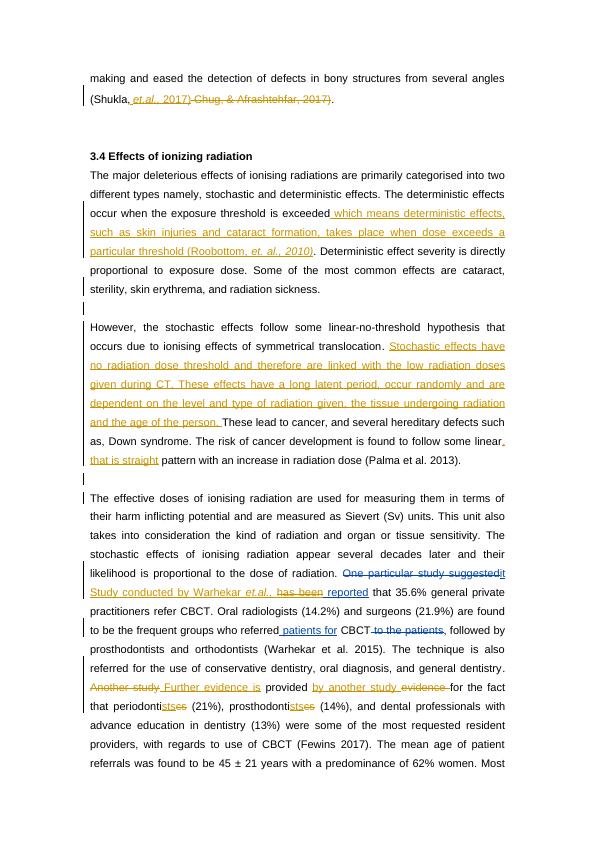
patient referrals were made from periodontology specialists (17%) and maxillofacial
surgeons (51%) (Arnheiter, Scarfe and Farman 2006).
3.5 Radiation protection
The use of the CBCT technique commonly spans a plethora of clinical procedures
and specialties namely, orthopaedics, radiotherapy; dental/maxillofacial, urology, and
other interventions (Okano & Sur, 2010). The number of CBCT scans and
intervention complexity also control the range of doses (Tsapaki & Rehani, 2007).
Radiation protection guidelines involve standard measurement of image quality and
doses across different manufacturers (Rawson 2015). Aggregate radiation dose
experienced by a population, defined as the product of the number of persons
exposed to a source and their average radiation dose. Availability of aggregate dose
is recommended (Paul, et. al., 2013) Mbalisike and Vogl 2013) for equipment that are
used in CBCT and fluoroscopy. Reduction of dose includes, designing the CBCT
equipment meeting the mechanical and electrical safety requirements, containing
electronic displays on the operator consoles, and presence of low dose protocols
(Rehani et al. 2015). Selections of high dose protocols may be needed in cases that
involve visualisation of soft tissues (de Gonzalez et al. 2013). Creating a balance
between the exposure and the quality needs help in optimising radiation dose.
Reduction of mA (Milliamperage) and kVp (Kilovoltage peak) for the equipment has
been found to create no significant loss of the quality of images. Another procedure
for radiation protection encompasses bringing about a reduction in the size of X-ray
beams to minimum needed size for imaging the object/organ of interest (Rehani et al.
2015). This has been found effective in limiting the dose of harmful radiation
exposure to the patients, in addition to improving the quality of images by scatter
reduction.
Imaging doses have been found to account for an estimated 2% or more of target
doses, with respect to first generation, linac (A linac (linear particle accelerator) is a
type of particle accelerator that accelerates charged subatomic particles or ions to a
high speed by subjecting them to a sequence of oscillating electric potentials along
a linear beamline mounted kV CBCT systems (SEDENTEX CT 2011). Thus,
radiation protection involves evaluation of the daily CBCT imaging for all patients, for
sensitive organs having lower thresholds for non-stochastic effects and paediatric
patients having high radiation sensitivity. Use of low-quality neurointervention scan
protocols, typically using fewer number of CBCT projections, are usually considered
sufficient for producing high-contrast structures such as, bony anatomy or contrast-
surgeons (51%) (Arnheiter, Scarfe and Farman 2006).
3.5 Radiation protection
The use of the CBCT technique commonly spans a plethora of clinical procedures
and specialties namely, orthopaedics, radiotherapy; dental/maxillofacial, urology, and
other interventions (Okano & Sur, 2010). The number of CBCT scans and
intervention complexity also control the range of doses (Tsapaki & Rehani, 2007).
Radiation protection guidelines involve standard measurement of image quality and
doses across different manufacturers (Rawson 2015). Aggregate radiation dose
experienced by a population, defined as the product of the number of persons
exposed to a source and their average radiation dose. Availability of aggregate dose
is recommended (Paul, et. al., 2013) Mbalisike and Vogl 2013) for equipment that are
used in CBCT and fluoroscopy. Reduction of dose includes, designing the CBCT
equipment meeting the mechanical and electrical safety requirements, containing
electronic displays on the operator consoles, and presence of low dose protocols
(Rehani et al. 2015). Selections of high dose protocols may be needed in cases that
involve visualisation of soft tissues (de Gonzalez et al. 2013). Creating a balance
between the exposure and the quality needs help in optimising radiation dose.
Reduction of mA (Milliamperage) and kVp (Kilovoltage peak) for the equipment has
been found to create no significant loss of the quality of images. Another procedure
for radiation protection encompasses bringing about a reduction in the size of X-ray
beams to minimum needed size for imaging the object/organ of interest (Rehani et al.
2015). This has been found effective in limiting the dose of harmful radiation
exposure to the patients, in addition to improving the quality of images by scatter
reduction.
Imaging doses have been found to account for an estimated 2% or more of target
doses, with respect to first generation, linac (A linac (linear particle accelerator) is a
type of particle accelerator that accelerates charged subatomic particles or ions to a
high speed by subjecting them to a sequence of oscillating electric potentials along
a linear beamline mounted kV CBCT systems (SEDENTEX CT 2011). Thus,
radiation protection involves evaluation of the daily CBCT imaging for all patients, for
sensitive organs having lower thresholds for non-stochastic effects and paediatric
patients having high radiation sensitivity. Use of low-quality neurointervention scan
protocols, typically using fewer number of CBCT projections, are usually considered
sufficient for producing high-contrast structures such as, bony anatomy or contrast-
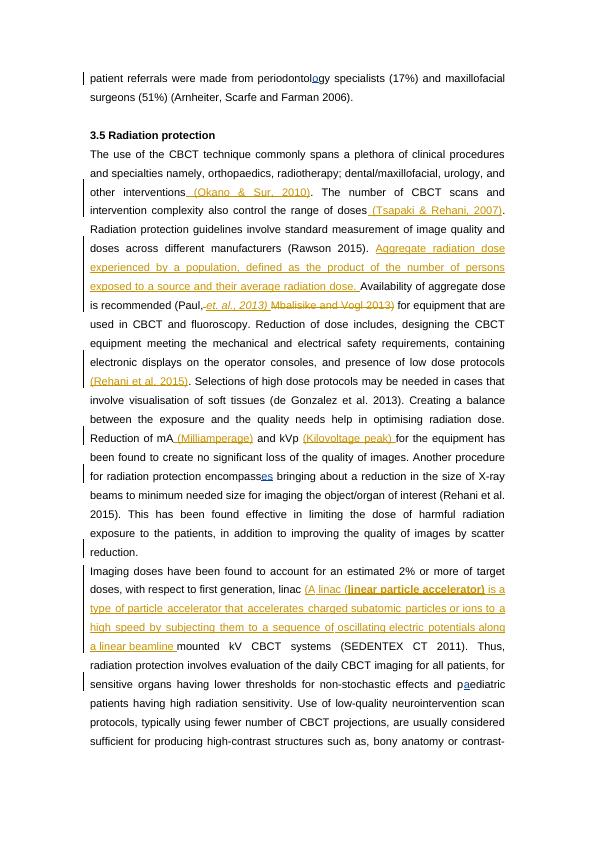
enhanced vessels. Maintaining sufficient distance from the source of x-rays and use
of shields are also effective radiation protection steps (Rehani et al. 2015).
3.6 Limitations of conventional radiography
Conventional X-rays use analog film or digital receptor in two-dimensional image of
the object. The anatomy in question is in 3 dimensions and radiographs compress
these into 2D images. Due to the nature of 2 dimensional images, the diagnostic
performance is increasingly limited (Webber et al. 1999, Nance et al. 2000). With this
technique, it is difficult to interpret the radiographs X-rays that give picture of the
surrounding structures while superimposing them. Conventional radiographs X-rays
do not demonstrate accurately the presence of lesions, its’ real size and spatial
relationship with the tooth’s anatomical structures (Cotti et al. 1999), (Cotti & Campisi
2004).
Geometric distortion is a major restraint in accurate diagnosis in endodontics
(Gröndahl & Huumonen 2004). The maxillofacial structures are not portrayed
accurately in its dimensions. Therefore it is recommended that peri-apical
radiographs must be taken using paralleling techniques as opposed to bisecting
angle techniques, for the above-mentioned reason (Forsberg & Halse 1994). Even
with the most accurate paralleling technique, one can expect a certain degree of
magnification (Forsberg & Halse 1994). Over-angulated or under- angulated
radiographs may give false measurements of true size of the peri-apical lesion or the
accurate root dimensions (White & Pharoh, 2004), (Whaites, 2007).
Multiple anatomical structures lying over each other may obscure the image, leading
to superimposition and difficulty in interpretation of these images (Gröndahl &
Huumonen 2004). The resolution of conventional radiographs X-rays is inferior to CT
and CBCT and it is not adequate in performing numerous diagnostic tasks in
endodontics (Huumonen & Ørstavik 2002).
These limitations that are overcome by three-dimensional radiographic techniques in
endodontic practice (Nemtoi, et.al, 2013).
3.7 CBCT Imaging process and Image interpretation:
In the recent years, CBCT has been specificallyally developed to produce three-
dimensional images (3D) that are scattered undistorted providing information on
maxillofacial skeleton with 3D images of teeth and its surroundings (Nemtoi, et.al.,
of shields are also effective radiation protection steps (Rehani et al. 2015).
3.6 Limitations of conventional radiography
Conventional X-rays use analog film or digital receptor in two-dimensional image of
the object. The anatomy in question is in 3 dimensions and radiographs compress
these into 2D images. Due to the nature of 2 dimensional images, the diagnostic
performance is increasingly limited (Webber et al. 1999, Nance et al. 2000). With this
technique, it is difficult to interpret the radiographs X-rays that give picture of the
surrounding structures while superimposing them. Conventional radiographs X-rays
do not demonstrate accurately the presence of lesions, its’ real size and spatial
relationship with the tooth’s anatomical structures (Cotti et al. 1999), (Cotti & Campisi
2004).
Geometric distortion is a major restraint in accurate diagnosis in endodontics
(Gröndahl & Huumonen 2004). The maxillofacial structures are not portrayed
accurately in its dimensions. Therefore it is recommended that peri-apical
radiographs must be taken using paralleling techniques as opposed to bisecting
angle techniques, for the above-mentioned reason (Forsberg & Halse 1994). Even
with the most accurate paralleling technique, one can expect a certain degree of
magnification (Forsberg & Halse 1994). Over-angulated or under- angulated
radiographs may give false measurements of true size of the peri-apical lesion or the
accurate root dimensions (White & Pharoh, 2004), (Whaites, 2007).
Multiple anatomical structures lying over each other may obscure the image, leading
to superimposition and difficulty in interpretation of these images (Gröndahl &
Huumonen 2004). The resolution of conventional radiographs X-rays is inferior to CT
and CBCT and it is not adequate in performing numerous diagnostic tasks in
endodontics (Huumonen & Ørstavik 2002).
These limitations that are overcome by three-dimensional radiographic techniques in
endodontic practice (Nemtoi, et.al, 2013).
3.7 CBCT Imaging process and Image interpretation:
In the recent years, CBCT has been specificallyally developed to produce three-
dimensional images (3D) that are scattered undistorted providing information on
maxillofacial skeleton with 3D images of teeth and its surroundings (Nemtoi, et.al.,
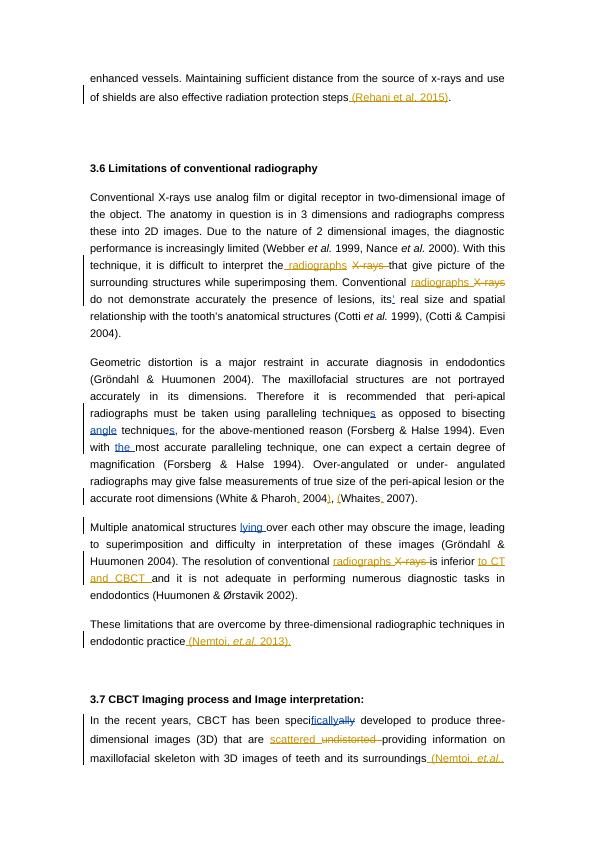
End of preview
Want to access all the pages? Upload your documents or become a member.
Related Documents
References on Dental Radiology and Imaginglg...
|2
|685
|487
Dental Radiography Principles And Techniqueslg...
|8
|1103
|483
Radiography Imaging Techniques - Assignmentlg...
|6
|2493
|341
Effectiveness of Cone Beam Computed Tomography in Endodontics: A Reviewlg...
|6
|1364
|191
CBCT in Endodontics: Advantages, Drawbacks, and Radiation Protectionlg...
|16
|5097
|278
Reducing Radiation Dose for Neonatal Patients During Chest X-Raylg...
|7
|2006
|152
